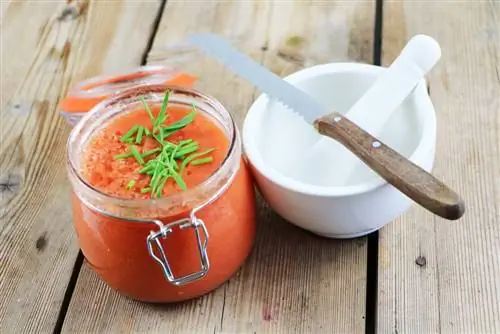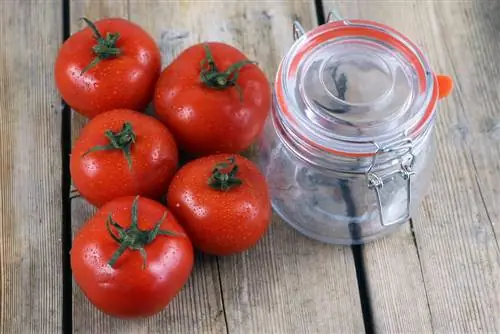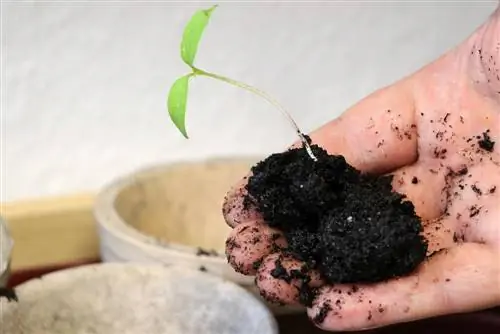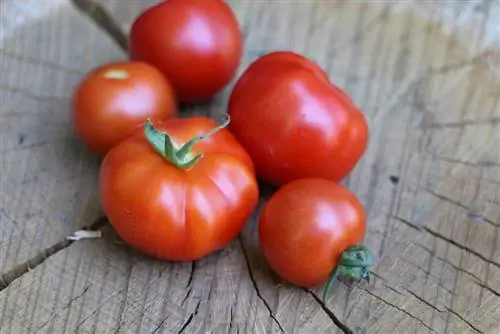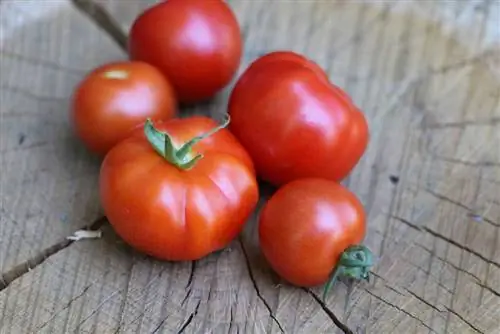- Author admin [email protected].
- Public 2023-12-17 03:39.
- Last modified 2025-01-24 12:45.
When people with cooking knowledge are asked what strained tomatoes are, they ask themselves whether they come from another planet because strained tomatoes are one of the basic ingredients in cooking. But people without extensive cooking knowledge also have to get to know these basic ingredients first, which is why the pureed tomatoes are presented in detail below:
Passed tomatoes are he althy
Yes, it has to be, the he althy ingredients are actually the most important thing in food and can therefore be mentioned first - especially when a he althy food is as tasty as the tomato. 100 grams of pureed tomatoes contain:
- only 38 kcal, which is a very low calorie content
- 0, 2 g fat
- 28 mg sodium
- 439 mg potassium
- 9 g carbohydrates
- 1, 9 g fiber
- 4, 8 g sugar
- 1, 7 g protein
- in relevant amounts of vitamin A, vitamin B6, vitamin C
- the minerals calcium, iron and magnesium
Above all, tomatoes have a very special substance to offer: lycopene, a tetraterpene belonging to the carotenoids, which gives tomatoes their typical red color. Lycopene is an antioxidant and is considered a radical scavenger because it neutralizes certain reactive, harmful molecules in the human body. With lycopene, the tomatoes themselves, which do not contain any cholesterol, also ensure that (bad) cholesterol cannot settle in the blood vessels.
Tip:
Passed tomatoes are one of the few foods that you can buy fully processed with a clear conscience because the content of he althy ingredients is equally positive. There may be losses in vitamins; But vitamin A needs are often met more quickly by a liverwurst sandwich or a few dried apricots, and when it comes to vitamin C, a slice of sea buckthorn provides significantly more. The B6, which is otherwise mainly contained in wheat germ, salmon, walnuts and vegetables (and is therefore not available in sufficient quantities for everyone), is hardly reduced; the mineral content and lycopene actually increase due to dehydration. We only consume significant amounts of lycopene in tomatoes (it is almost only found in tomatoes). Fresh tomatoes contain 3 to 6 mg per 100 g of fruit, canned tomatoes approx. 10 mg (as they are usually only harvested when ripe), concentrated tomato paste approx. 62 mg lycopene.
Soured tomatoes are a great kitchen helper
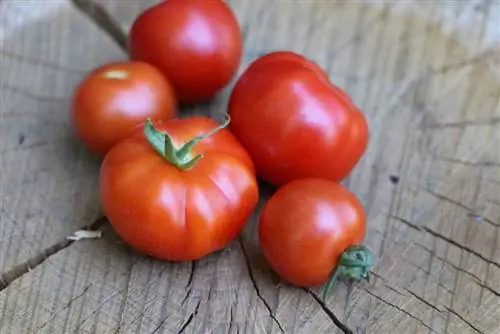
Passed tomatoes are crushed tomatoes; uniform tomato puree that can be used wherever tomato flavor without chunks is desired. With which even novice cooks and even people who never cook on principle can prepare attractive and tasty snacks “in seconds”:
- The more strained tomatoes are reduced in a pot or microwave, the more intense the tomato flavor becomes
- The following snacks can be prepared with any desired concentration level of pureed tomatoes
- Catalan 'Pa amb tomàquet': toast bread, rub with garlic, spread gently with pureed tomato, drizzle with olive oil, with cheese and ham in pieces
- Tomato soup: boil carrots and celery in pureed tomatoes with soup greens, pepper, s alt, soup seasoning until soft, add onions fried in oil, puree, season to taste
- The soup becomes creamy with cream, English with gin, Indian with curry, Italian with sage, Mexican with chili, French with herbs from Provence, very local with rice
- With a few characteristic ingredients such as white beans, minced meat, kidney beans, croutons, a classic for every day of the week
- Cold pureed tomatoes are combined with white bread, green peppers, cucumbers, garlic, olive oil, vinegar, s alt and water (crushed in a mortar or sent through the blender) in no time to make Spanish gazpacho
- Tomato mayonnaise or sauce andalouse is one of the classic sauces for Belgian fries
- The sauce made from tomatoes + mayonnaise, mixed as desired, is also the basis of the classic cocktail sauce
- With a few spices (ketchup, horseradish, mustard, lemon, Tabasco, Worchester, ginger, curry, sherry, cognac, Madeira, and/or) the shrimp or poultry deli salad is ready very quickly
- Then a few meat skewers in the oven or pan, cocktail sauce with/without chili and herb mayonnaise as grill sauces + large bowl of mixed salad, and the guests can come
Tip:
The part of the garden tomatoes that is not eaten immediately becomes pureed tomatoes in the blender in no time; or cut and strained through a sieve to make pureed tomatoes without any trace of tomato peel. Which can go in a preserving jar on the pantry shelf, but can also be enjoyed as a fresh, vitamin-rich tomato drink. It doesn't necessarily have to be the red smoothie that isn't very tempting for many people, rather mix your own spicy or sweet tomato cocktail: A "Virgin Bloody Mary" that makes you super fit (and not super sneaky drunk), made from tomato juice, lime juice, Serve Tabasco sauce, Worcestershire sauce, celery s alt, pepper, with an elongated piece of celery stick and ice cubes in a long drink glass. Sweet tomato is a culinary challenge, but it works by modifying recipes that are usually prepared with the relative Tamarillo: Mix pureed tomatoes, pomegranate juice and 1 teaspoon of grenadine syrup, pour through a fine sieve with a cotton cloth, decorate and enjoy.
Passed tomatoes are indispensable in many classic delicacies
Forget about the red sauce that usually accompanies “Spaghetti Bolognese”. In Italy, “Ragù alla bolognese” is served as part of a pasta asciutta (that's the name of the entire pasta dish including the noodles) as the following rich and long-simmered meat sauce: lean beef, pancetta, carrots, celery, chicken liver, pureed tomatoes and/or Tomato paste, onions fried in olive oil, finely chopped dried porcini mushrooms, bay leaves, cloves and a little nutmeg are cooked over low heat for at least 2 hours, if necessary.mixed with a little cream and then eaten with tagliatelle.
Ossobuco, the delicious braised veal knuckle from Milanese cuisine, also doesn't do well without pureed tomatoes in the braising sauce, as does Parmigiana (a layered casserole made from vegetables, Parmesan cheese and cooked in the oven, which is common in Parma in southern Italy). tomato sauce), the sauce all'arrabbiata for the popular, rather fiery penne or the peperonata (braised dish made from peppers, tomatoes and onions).
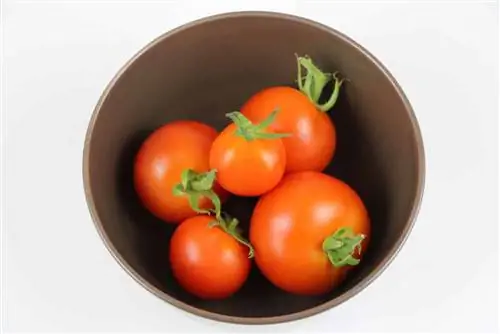
For the Greek casserole dish moussaka, in addition to pureed tomatoes, you only need a few layers of minced meat that has been fried with onions and garlic and seasoned with cumin, savory, cinnamon and allspice, and a top layer of béchamel sauce sprinkled with cheese. Greek Stifado consists of cubes of beef or rabbit, which are fried with plenty of onions, other vegetables, bay leaves, cinnamon, allspice, cumin, cloves and pureed tomatoes and quenched with the red sweet wine Mavrodaphne.
The Hungarians don't put anything on their lecho, which apart from spiciness, bacon, yellow pointed peppers and onions only needs pureed tomatoes; Bulgarians call the almost identical “stewed tomatoes with content” ljutenica, the Macedonians call it pindjur (eggplant, tomatoes, onions, garlic), the Romanians call it zacuscă and the Russians call it ogonek (tomatoes, onions, s alt, red pepper, garlic, chili). North Africans and Israelis serve eggs poached in a sauce made from tomatoes, chilies and onions called shakshuka, Turks know this sauce as menemen and serve it with yogurt with eggplant, zucchini and potatoes, Spaniards call it pisto and serve it with fried eggs.
In Algeria, the almost identical chakhchoukha is served with semolina, lamb, eggplant and zucchini and the English love tomato-chili relish on a typical English sandwich, for example with turkey and bacon. Portuguese and Latin Americans eat the tomato sauce as a sofrito, which is mixed with olive oil, onions, garlic and possibly.various root vegetables, Basques saute pureed tomatoes with sweet peppers, Bayonne ham, onions and garlic in olive oil, pour the whole thing over with beaten eggs and call this type of omelet piperade.
How to make pureed tomatoes your children's favorite dish
The pureed tomatoes have really gone around the world, especially as a seasoned sauce - there seem to be few people who don't like the taste of well-seasoned tomato sauce. There is also a well-seasoned tomato sauce that has conquered the whole world under its own name: ketchup; unfortunately not with an unchanged recipe.
Tomato ketchup was originally nothing other than one of the seasoning sauces just described based on boiled pureed tomatoes. The early recipes from today's market leader Heinz (now part of the Kraft Heinz Company, in its early days was just one of many manufacturers in the USA) have been handed down. One recipe from 1883 seasoned the tomatoes with vinegar, cloves, cayenne pepper, nutmeg, cinnamon and allspice, while a second used ginger, mustard seeds, celery, horseradish and brown sugar.
What well-seasoned means varies with the zeitgeist; and the zeitgeist of industrial food production has forced one “spice” above all on the world’s favorite tomato sauce: sugar. The contents of today's ketchup bottles therefore look a little different: tomatoes, brandy vinegar, sugar, s alt, spice extract, herb extract, spices. It is listed according to the amount of ingredients, sugar content (around 25 g) and s alt content (around 5 g) are known. So 30% “block” in the middle, then there must be more than 25% brandy vinegar and more tomatoes than brandy vinegar. Tomatoes are added as dry matter, depending on the manufacturer 120 - 150 g of tomatoes in the form of at least 6% tomato dry matter (prescribed) + water.
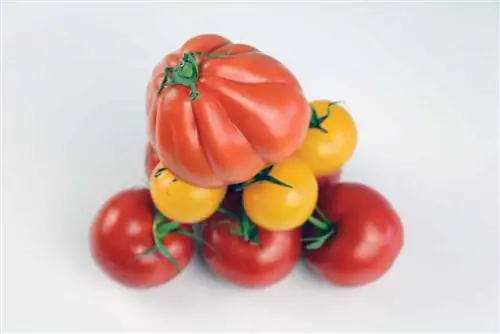
Actually not a bad recipe, except for the huge amount of sugar and vinegar, which can reduce the quality of life of ketchup fans: One tablespoon of ketchup has 20 g and not 10 g because nobody uses a level tablespoon of ketchup; The ketchup lake on/next to fries or schnitzel quickly reaches 3 tablespoons and contains 60% of the daily sugar amount of approx. 25 g, which is harmless to he alth according to the WHO. There isn't much left for sugar in coffee, tea, jam, cakes, ice cream, chocolate and so the average sugar consumption of Germans in 2013 (last overview study) was 32.7 kg per person (∼ 90 g daily from babies to old people, the last figures before the start of industrial food production are from 1874 and report 6.2 kg of sugar per person per year, 17 g daily).
This is self-harmful eating behavior because too much sugar disrupts the body's own insulin production, which means that you are setting your body up for diabetes, obesity, etc.“reprogrammed”. It is also an anti-pleasure eating behavior because it accustoms the taste receptors to sweeter, sweeter, sweeter, but even sweets that are too sweet only taste sweet and are not satisfying. The cheap brandy vinegar made from ethyl alcohol of agricultural origin is only guaranteed to be free of genetically modified plants or bacteria in organic vinegar; it is not he althy for everyone anyway and is also not a substitute for the valuable ingredients in tomatoes; In the remaining few percent of spice extract, herbal extract, spices, it is not clear what can be in there, from thickeners to the criticized food additive.
Your own ketchup can be made from pureed tomatoes without much effort: 1 kg of pureed tomatoes with 0.2 kg of chopped red peppers, 0.1 - 0.2 kg of chopped onions, simmer for approx. 40 minutes with the pot lid on at an angle, After 20 minutes, add 0.1 liter of red wine vinegar, the family's own seasoning mixture of s alt, pepper, garlic, nutmeg, mustard, bay leaf, chili, cloves, cinnamon (all or some of the spices) and (brown) sugar or honey to taste.100 g of sugar would be 10%; for people with a fairly normal sensitivity to sweetness, tomatoes' own sugar is sufficient. When the mixture is thick enough, puree it with a hand blender and pour it into screw-top jars. It will keep for approx. 3 months.

